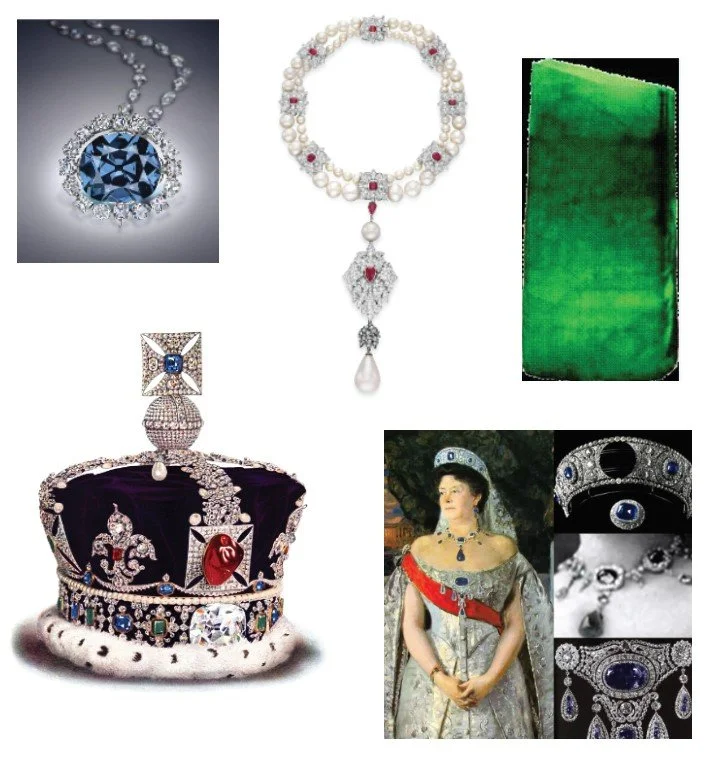Junior Collection, 22-23
The Gemstones collection is based on specific historical gemstones with fascinating stories that inspired this line of sultry and unusual lingerie.
Mood Board
Research Cont.
Target
Color Story
Final Sketch
Research
Sketches
Renderings
Discovered in India in 1666, its original form was known as the Tavernier Blue—a rough cut, 115 carat triangular gem. In 1678, Louis XIV commissioned the court jeweler to recut the “Blue Diamond of the Crown of France” and it was set in gold with a ribbon for the neck and was worn by the king during special occasions. It was later reset by Louis XIV's great-grandson, Louis XV in 1749. The French Blue disappeared during the French Revolution and was likely smuggled to London. It was rediscovered as the “Hope Diamond” as it belonged to the Hope family, and was in the current setting of a medallion surrounded by white diamonds. It was eventually donated to the National Museum of Natural History, where in 2010 it was featured for a short time in a new setting called “Embracing Hope”—of which this design is based on.
Hope Diamond
La Peregrina, a drop-shaped 1 inch long natural pearl, was discovered in the Gulf of Panama in the late 1500s and was immediately sent to King Philip II of Spain. It was considered a treasure of the Spanish Crown and remained in the possession of the royal family until the early 1800s. Following Napoleon’s short-lived invasion, his brother, Joseph Bonaparte, brought the pearl to France. Napoleon III eventually sold it to the English Duke of Abercorn, whose wife lost the pearl multiple times, even once in a sofa inside Buckingham Palace. It remained in the within the family until 1969 when it was purchased Richard Burton and then given to Elizabeth Taylor. Taylor infamously lost and then found La Peregrina in the mouth of one of her Pekinese dogs. She wore it in various iconic photographs and films, and following her death it was sold at auction to an anonymous buyer.
La Peregrina
Queen Marie of Romania began her impressive sapphire collection through wedding presents, including a 137. 2 carat sapphire set in a tiara, in which she wore for her Coronation in 1922. She gave her daughter, Princess Ileana, the tiara as a a present when she married in 1931. Ileana then loaned the tiara back to her mother to wear for the 1935 Silver Jubilee of King George V. As political tensions grew Marie left the tiara in her London bank for safekeeping and was reclaimed by Ileana shortly before the outbreak of World War II. Shortly after she and her family fled to the United States, following the fall of the Romanian Monarchy in 1948. Desperate for money, the family sold off the tiara—now lost to history.
Queen Marie Sapphire
The Black Prince's Ruby is a red spinel weighing 170 carats that is believed to have originated in present day Afghanistan. Early accounts date back to the middle of the 14th century as the possession of the Arab Muslim Prince of Granada. He was confronted by the King of Castile, Don Pedro the Cruel, who stabbed Prince Sa'īd to death himself and then took the spinel for himself. In 1366, Don Pedro's brother led a revolt against him, which led him to make an alliance with the Black Prince, the son of Edward III of England. The revolt was ended and the Black Prince took the ruby in exchange for his assistance. It disappeared from historical records until 1415 when Henry V of England wore it in a helmet during his French campaign, in which Henry nearly lost both the helmet and his life. The spinel remained in royal posession until the 17th century when Oliver Cromwell dismantled and sold the symbols of the king's power. The gem reappeared in the possession of Charles II in 1660, when the monarchy was restored. The Black Prince’s Ruby was also seen at the coronation of Queen Victoria in 1838, as part of her new crown which included 3,093 gems--with the spinel at the front. Queen Elizabeth wore the same crown, including the Black Prince’s Ruby, in her coronation portrait.
Black Prince Ruby
The Isabella Emerald is 964 carats and is an ancient, rectangular gemstone, originating from the Muzo mines of Colombia. The King of the Aztec Empire, Montezuma, gifted the “Emerald of Judgment” to Hernan Cortez in 1519. In his letter to Queen Isabella of Portugal, Cortez described the gemstone as “a mystifying powerful emerald crystal so large that it would fill the palm of her hand.” In 1757 the emerald was lost between Mexico and Spain, when the Spanish ship it was travelling on caught firre and sank in what is now considered the “Bermuda Triangle”. Along with the Isabella Emerald were hundreds of chests containing emeralds, gold, and Aztec artifacts. The shipwreck was discovered about 12 miles offshore of the Florida coast in 1987, and recovered from the site were over 1 million carats of emeralds.





















